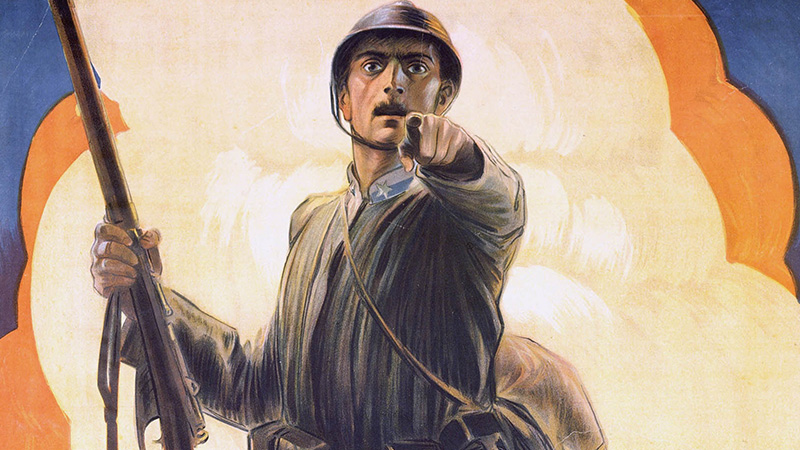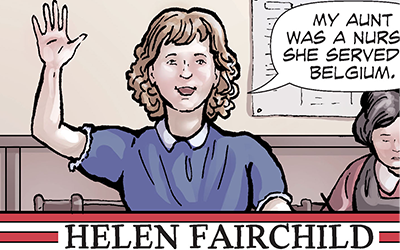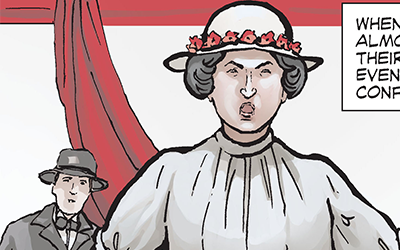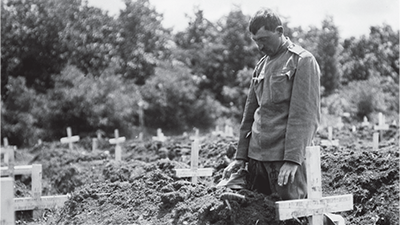Living in Total War
Driving Question: How were different groups of people affected by the First World War?
What did it mean to be part of the lost generation? Firsthand perspectives from the war reveal the fear, courage, and resilience that shaped the lives touched by total war.
Learning Objectives:
- Use close-reading skills to understand how the First World War impacted soldiers, civilians, and entire communities in different ways.
- Practice quick sourcing to evaluate how different individuals and groups experienced and responded to the First World War.
- Use a graphic biography to support, extend, or challenge the overarching narratives of this period.
Vocab Terms:
- antisemitism
- casualty
- conscription
- socialist
Opener: Living in Total War
To teach this lesson step, refer to page 2 of the Lesson 6.4 Teaching Guide.
Step into the shoes of someone living through World War I. Use what you’ve learned to imagine how war felt, not just how it was fought.
Voices from Total War
To teach this lesson step, refer to page 3 of the Lesson 6.4 Teaching Guide.
Practicing historical empathy is core to understanding historical accounts. But, it can be tricky…. read about The Slippery Slope of Teaching Historical Empathy in this Forum thread.
World War I changed not just nations, but the lives of everyday people. To better understand its emotional and human impact, analyze a collection of wartime voices and write a letter from the perspective of someone living through total war.
War on the Homefront
To teach this lesson step, refer to page 4 of the Lesson 6.4 Teaching Guide.
Have your student use the Three-Step Reading for Graphic Biographies tool to structure their approach to reading this type of text.
Compare graphic biographies about two very different women who experienced World War I. Then, read an article and complete an activity to help you evaluate the long-term effects of the conflict.
-
Guiding Questions
-
Before you read
Preview the questions below, and then skim the comic, paying attention to things like prominent colors, shapes, and types of text and fonts. How do you know where to start and in which direction to read? What’s in the gutters (the space between panels)? Who or what is the focus of the comic?
While you read
Look for answers to these questions:
- What did someone say about Helen Fairchild’s service in World War I?
- What work did Helen Fairchild do during the war?
- How did Helen Fairchild die?
- How is Helen Fairchild remembered today?
- How is the shape of the four central panels meaningful to this story?
After you read
Respond to this question: How does Helen Fairchild’s story add to your understanding of how people experienced and remembered World War I?
-
Guiding Questions
-
Before you read
Preview the questions below, and then skim the comic, paying attention to things like prominent colors, shapes, and types of text and fonts. How do you know where to start and in which direction to read? What’s in the gutters (the space between panels)? Who or what is the focus of the comic?
While you read
Look for answers to these questions:
- Where was Rosa Luxemburg born?
- What were some of Rosa Luxemburg’s major accomplishments?
- How did Rosa Luxemburg feel about the First World War?
- How does the artist visually show Luxemburg’s emotions about the war?
- How is the shape formed by the central panel in the comic meaningful to the story?
After you read
Respond to these questions: How does Rosa Luxemburg’s opposition to the war compare to Helen Fairchild’s choice to serve? Whose decision do you relate to more?
-
Guiding Questions
-
Before you read
Preview the questions below, and then skim the article. Be sure to look at the section headings and any images.
While you read
Look for answers to these questions:
- Why were people excited when the war first began?
- How did governments encourage young men to join the war?
- Why did both soldiers and civilians feel a sense of disillusionment during the war?
- What are the two meanings of the term lost generation?
- How did people around the world respond after the war ended?
After you read
Respond to this question: Do the ideas in this article support the belief that the world was becoming more advanced and connected during this time? Explain your response.
Closer: Living in Total War
To teach this lesson step, refer to page 7 of the Lesson 6.4 Teaching Guide.
It’s often easy to see how those closest to the battlefield were impacted by war. But even those who were hundreds of miles away felt the impacts of this global and total war.







